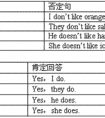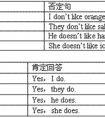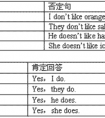句型转换。1. This is my pencil case. (改为一般疑问句) _________________________________________________________________2. My name is Lisa Green. (对画线部分提-六年级英语
I won't do it at all.
I can't see it any more.
He is no longer a boy.
否定转移的形式与用法:
一、动词的否定转移
1.形式上否定主句的谓语,实际上是否定从句的谓语
当动词“think”、“believe”、“suppose”、“imagine”、“expect”、“feel”的主语是第一人称,谓语动词为没有任何副词修饰的一般现在时,它们的否定式实际上是对宾语从句的否定。
表示说话者提出一种委婉的看法或主张。如:
I think that he will help us.——I don’t think that he will help us. 我认为它不会帮助我们。
I believe that he is right.——I don’t believe that he is right. 我认为他不对。
I suppose that he likes it.——I don’t suppose that he likes it. 我想他不喜欢它。
2. 形式上否定谓语动词,实际上否定复合宾语
当动词“think”、“believe”、“suppose”、“imagine”、“expect”、“feel”、“find”的主语是第一人称,谓语动词为没有任何副词修饰的一般现在时,它们前面的否定式实际上是对复合宾语的否定。表示说话者所提出的一种委婉的看法或主张。如:
I think math difficult. — I don’t think math difficult. 我认为数学不难。
I find the story interesting. — I don’t find the story interesting. 我认为这个故事没有趣。
I expect so. —I don’t expect so. 我认为不会。
二、动词“think”、“believe”、“suppose”、“imagine”、“expect”、“feel”在下列情况下,否定不转移:
1.这些动词跟其他另一个动词一起做并列谓语时,否定不转移。如:
I believe and hope he won’t do that. 我相信并且也希望他将不会那样做。
I feel and admit that we are not foolish. 我觉得并且也承认我们并不愚蠢。
2.用于疑问句时,否定不转移。如:
Do you think it is not going to rain? 你认为天不会下雨吗?
Don’t you believe that he has done a good thing? 难道你不相信他做了一件好事?
3.用作插入语时,否定不转移。如:
Li Lei, I think, won’t be angry with you. 我想李蕾不会生你的气。
Tom, I suppose, won’t be against it. 我猜想汤姆不会反对。
Mike, I believe, hasn’t seen the film. 我认为迈克没有看这场电影。
4.动词前有其他副词修饰时,否定不转移。如:
I really don’t think it’s necessary for us to go there now. 我的确不认为我们有必要去那儿。
I feel strongly that he shouldn’t do such a thing. 我强烈地认为他不应该做那样的事。
5.动词为非一般现在时或主语不是第一人称时,否定不转移。
I thought that he wouldn’t come back soon. 我原以为他不会回来得这么快。
She didn’t believe that he became a good boy. 她不相信它变成了一个好孩子。
He thinks that he isn’t fit for the job. 他认为他不适合这件工作。
He doesn’t believe that what we told him is true. 他不相信我们告诉他的事是真的。
6.当宾语从句中含的否定为“not……at all”、“not a little”、“not a few”、“not enough”、“can’t help”等固定搭配时,否定不转移。如:
I think that he doesn’t know it at all. 我想他对那一点也不知道。
I suppose that it is not enough to remember the words if you want to learn the language well. 我认为如果你想把这门语言学好,那么只记单词是不够的。
I believe that you can’t help singing our national anthem when you win the first place in the Olympic Games. 我相信当你在奥运会上获得第一名时你会情不自禁地唱起国歌来。
7.当宾语从句中含“no”、“nothing”、“nobody”、“nowhere”、“hardly”、“seldom”、“little”、“few”等否定词或半否词时,否定不转移。如:
I believe that nothing can make me give it up. 我想任何事情也不能使我放弃。
I think that no one can escape if the ship sinks in the sea. 我认为如果这艘船沉入海底的话,那么谁也逃不掉。
I suppose that he is a man of few words. 我猜想他是一个言语不多的人。
考点名称:陈述句
- 陈述句:
是陈述一个事实或者说话人的看法。它包括肯定句和否定句两种。陈述句在书写时句末用句号,在朗读时用降调。
陈述句中动词位置:
陈述句是用来描述一个事实。日常生活中使用的大部分句子都是陈述句。
在陈述句中动词在第二位。第一位可以是主语,也可以是状语,还可以是宾语。而不管句子怎么变,动词(或者助动词)总是在第二位。
主语的位置则总是在动词的两边,要么在第一位,要么在第三位。
当出现助动词或情态动词时,助动词或情态动词在第二位,行为动词在最后一位。 陈述句分类:
陈述句分为肯定句和否定句(全否定和半否定)
简单地说,表达事物的“Yes”这一面的句子就是肯定句,“No”的一面的就叫做否定句。
传统的英语入门都是先学肯定句,然后再学肯定句的反面,亦就是否定句。
一、肯定句:
基本结构为:主+谓
He went to London to pass his holiday.
二、否定句:
1、全否定
用not,no,never,neither,none,nothing等否定。表示“完全不是,完全不”的意思。
Nothing is wrong with me.
2、半否定句
在句子里用否定词hardly,scarcely,little,few,seldom,rarely等。
I hardly see anything in the room.=I can see little in the room.
“all/both/every/each/+谓语+not”表示概念为“有的是,有的不是”
All of them are not students.=Some of them are students,some are not.
3、宾语从句的否定形式
用在think,believe,suppose引导的宾语从句里则否定主句。
I don't think he'll come.=He will not come in fact,I think.
三、否定句的表达方式
1、使用副词否定词“not”
(a)be,have为主要动词
He has not many friend here. (在这里他没有很多朋友。)
解说:“be/have +not”常缩短成一词,尤其是日常谈话更是如此。
“am +not”不是“amn't”,而是“aren't”或“ain't[eint]”,
I am very nice to you,aren't I? (我对你很不错,是不是?)
美国人用“ain't”很随便,应该是“are not,is not,have not,has not”的地方,他们也会“ain't”一下就带过去,宜注意。
(b)be,have为助动词
He hasn't yet paid the money. (他尚未付钱。)
be+ V -ing(进行时),be +P.P.(过去分词)(被动词态),have(has,had)+P.P.(完成时)等的“be,have(has,had)”皆为助动词。
“be going to …”在学校文法中也常被视为助动词。
(c)“助动词+V”时
动词带有助动词“will,shall,can,may,must,need,dare,ought to,used to,had better”等时,将“not”置于助动词与主要动词之间。
You had better not tell her everything. (你最好不要样样事情都告诉她。)
注:“can”的否定形式是“cannot / can't”,不可写成“can not /cann't”。
(d)使用助动词“do”的否定句
一般动词的否定句通常使用助动词“do”,句式如下:do(does,did)+not + V(原形动词)
Don't believe him. (不要相信他的话。)
注:“have”表达“有”以外的意义时,其否定句通常使用助动词“do
We didn't have (=enjoy) a good time there yesterday. (昨天我们在那里玩得不愉快。)
不过美式英语“have”作“有”的意义使用时也如一般动词使用助动词“do”
I don't have brothers. (我没有兄弟。)
2、使用“not”以外的否定词:
(a)副词:never,seldom,hardly,little,neither等
She seldom comes to see me. (她不常来看我。)
(b)形容词:no,few,little等
He has few friends in Hong Kong. (他在香港几乎没有朋友。)
(c)代词:nothing,nobody,none等
I found nobody about computer. (在那栋房子里我没看到任何人。)
注:
①.有些文法书认为“Not +V”为句子否定法,是否定句,而“no +n.或如nothing等”为单词否定法,不宜称为否定句。
He has no breakfast. (他没有早餐可吃。——单词否定,肯定句)
②.否定也可以借用前缀或后缀来表达
They are childless.(=They don't have children.) (他们没有小孩。)- 句式互换:
1.陈述句变反问句:
原句+疑问词(怎能;难道)+不+语气词(呢?;吗?)-句号+问号
2.反问句变陈述句:
原句-疑问词(怎能;难道)-不-语气词(呢?;吗?)-问号+句号
3.反问句变陈述句:
去掉问号,有加强反问的语气词去掉,在变换后的陈述句中适当的地方必须加一个否定词,才与原反问句意思一致。
比如:“难道他承认人的正确思想是从天上掉下来的吗?”变换陈述句:“他不承认人的正确思想是从天上掉下来的。”
若变换为“他承认人的正确思想不是从天上掉下来的。”就与原反问句的意思不一致了,答案就是错的,因为否定词“不”放的位置不当。
同样,肯定句变反问句,在变换后的反问句中,必须在适当的地方加一个否定词,才与原句意思一致。
比如:“你应该去看他。”变为:“难道你不应该去看他吗?”
4.否定句变反问句:
去掉句中否定词或在变换后的反问句中再放上一个否定词,才与原句意思相符。
- 最新内容
- 相关内容
- 网友推荐
- 图文推荐
| [家长教育] 孩子为什么会和父母感情疏离? (2019-07-14) |
| [教师分享] 给远方姐姐的一封信 (2018-11-07) |
| [教师分享] 伸缩门 (2018-11-07) |
| [教师分享] 回家乡 (2018-11-07) |
| [教师分享] 是风味也是人间 (2018-11-07) |
| [教师分享] 一句格言的启示 (2018-11-07) |
| [教师分享] 无规矩不成方圆 (2018-11-07) |
| [教师分享] 第十届全国教育名家论坛有感(二) (2018-11-07) |
| [教师分享] 贪玩的小狗 (2018-11-07) |
| [教师分享] 未命名文章 (2018-11-07) |





![____ it got four wheels?[ ]A. Have B. There C. Has-五年级英语](http://www.00-edu.com/d/file/ks/4/1/65/2019-08-31/small2ca0aeba76320ba6f81e40fe83a0e8111567199443.png)
